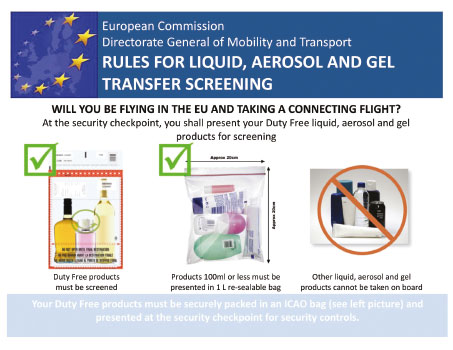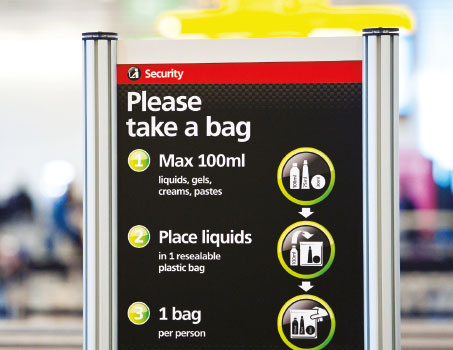Restrictions on the carriage of LAGs (liquids, aerosols and gels) redefined the whole airport security experience when they were hurriedly introduced in 2006. Time and again continuing security concerns have delayed relaxation of the rules, most recently the April 2013 deadline for the removal of all restrictions was replaced with a new roadmap and a phased approach designed to ensure operational feasibility while maintaining the desired high levels of security.
The new LAGs regime introduced on 31 January is therefore a very important first step, and represents the result of hard-won cooperation between industry stakeholders, including ACI EUROPE, the European Commission, national authorities and other international partners.
It is also estimated that Europe’s airports have invested over €150 million to accommodate the new rules, and ACI EUROPE, in collaboration with other industry stakeholders, has produced advice to passengers clearly defining what the new rules mean.
“This is part of our investment toward getting back to the good old days before 2006, when there were no restrictions,” commented Olivier Jankovec, Director General, ACI EUROPE. “We are committed to reaching that ambitious end goal. This will require further advancements in screening technology, in terms of security, operational feasibility and passenger facilitation. It’s only by taking all these into account that we will remove the hassle out of this aspect of air travel.”
The new first phase involves a limited range of liquids. The most visible change is for transferring passengers, who no longer have to surrender their duty free purchases from non-EU airports. Enhanced technology is used to screen duty free LAGs purchases over 100ml, which must be presented in Security Tamper Evident Bags (STEBs) and with proof of purchase. Liquids needed for medical purposes or special dietary requirements, including baby food, are also allowed.

ACI EUROPE, in collaboration with other industry stakeholders, has produced advice to passengers clearly defining what the new LAGs rules mean.
It is also worth noting that the new rules have been adopted in coordination with major EU trading partners, which have introduced equivalent rules, including the US, Canada and Australia. This means that EU passengers are able to carry their LAGs in STEBs when transferring in those countries.
The confiscation of duty free LAGs has had a serious detrimental impact, creating uncertainty for passengers unsure what they can carry onboard, and seriously impacting sales of liquor and cosmetics.
The European Travel Retail Confederation (ETRC) has been deeply involved in the LAGs issue since it first began, ensuring there is an effective and secure regime that also takes into account the concerns and needs of travel retail. “The current change to the rules could not have taken place without close cooperation between all the many stakeholders involved and ETRC has worked alongside all of them, particularly ACI EUROPE,” explained Frank O’Connell, Vice President and Strategic Advisor, ETRC. “This has been recognised by the European Commission and by the Transportation Security Administration (TSA).”
The ETRC has encouraged a “soft launch” approach to this first phase in order to allow the new regime time to “bed down” and airport security personnel to gain confidence in the changed systems. “As passengers and airports become more at ease with the new regime, ETRC expects that this will bring new opportunities for travel retailers everywhere and lead, in time, to a recovery in sales,” added O’Connell.

Collaborative efforts by the European Commission, TSA and industry stakeholders, including ACI EUROPE, will continue with the aim of finding a comprehensive solution for identifying liquid threats that facilitates the full lifting of LAGs restrictions, while maintaining security. © Heathrow Airport
Collaborative efforts by the European Commission, TSA and industry stakeholders, including ACI EUROPE, will continue with the aim of finding a comprehensive solution for identifying liquid threats that facilitates the full lifting of LAGs restrictions, while maintaining security.
Marjeta Jager, Director of Security for the Directorate-General for Transport and Mobility of the European Commission, told Airport Business: “We are very pleased that the first phase of lifting the restrictions on liquids introduced on 31 January at EU airports has been a full success from an operational point of view. We congratulate ACI EUROPE and all airports for their excellent work that allowed the implementation of this phase, and we are looking forward to continuing our cooperation with stakeholders and international partners on all security issues.”
The European Commission has appointed consultants to monitor and assess the impact of phase one of the new regime, with a view to moving on to the next stage of the journey towards the full lifting of restrictions, when operationally feasible, while ensuring that high levels of security are maintained.







